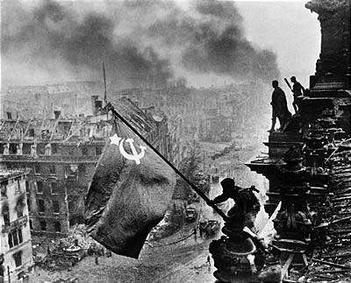Yevgeny Khaldei
Yevgeny Khaldei | |
|---|---|

A Red Army soldier raising the Soviet Flag over the Reichstag by Yevgeny Khaldei. [1] | |
| Born | March 23 [O.S. March 10] 1917 |
| Died | October 6, 1997 (aged 80) |
| Occupation | Photojournalism |
Yevgeny Khaldei (March 23 [O.S. March 10] 1917 - October 6, 1997) was a world renowned Red Army photographer, best known for his World War II photograph of a Russian soldier placing the Soviet Union's Red flag atop the Reichstag building in Berlin, signifying the fall of Germany.
Life
Khaldei was born in a Jewish family in Ukraine and had been obsessed with photography since childhood, having built his first childhood camera out of his grandmother's glasses. He started working with the Soviet press agency TASS at the age of nineteen as a press photographer.
Khaldei was also witness to several pivotal moments in history and is particularly reputed for his photographs during World War II and the Nuremberg Trials[2]. Khaldei worked with the TASS until 1949, when he was fired due to the growing anti-semitism by the Soviet state. For the next ten years, he worked as a private freelance photographer, focusing on scenes from everyday life. In 1959, he got a job again at the newspaper Pravda, where he worked until he was forced to retire in 1970, again because of his Jewish background.[3] Even though the flag over the Reichstag is one of his most famous works officials in the Soviet government never published who the photographer was. Khaldei's international fame dates from the fall of the Soviet Union, in 1991.
Works
Khaldei's most renowned photographs were taken when he was a Red Army photographer from 1941 to 1946. Khaldei's photographs emphasised his feelings for the historic moments and his sense of humour. One of the more famous anecdotes was during the Nuremberg Trials, where Hermann Göring was being tried. Khaldei says about the Göring shot:
When we received orders to leave Nuremberg, I asked an American colleague to photograph me with Göring. Göring remembered that, because of me, he had been hit with a club, and hence he always turned his head aside when I came into the courtroom. When he noticed I wanted to get into the picture with him, he put down his hand in front of his face.
— Khaldei
While Khaldei frequently staged or manipulated his photographs, he insisted that this was to signify the importance and add strength to a particular event. His work was also admired by the elites of the Soviet Union and he is renowned for creating commissioned portraits for State leaders such as Joseph Stalin, Mikhail Gorbachev and Boris Yeltsin.
Red Army Reichstag photo
Khaldei's most famous photo was of a Soviet Red Army soldier waving a flag above the German Reichstag at the end of World War II. The photo represented an historic moment, the default of Germany in a war that cost the Soviet Union tens of millions of lives. The photo was originally published 13 May 1945 in the magazine Ogonjok.[4] Celebrated as the image is, it was a reconstruction of a moment that had happened earlier but had been missed by the camera (the first persons in the Reichstag were not on the picture). The original flag raising happened at 10:40 PM on April 30, 1945 when 23-year old Mikhail Minin climbed the statue and inserted the flag into the mounted statue, Germania's, crown. As this happened at night it was too dark to take a photograph. The next day the flag was taken down by Nazi holdouts who were only defeated after a few days of fighting. Finally on May 2, 1945 Khaldei scaled the now pacified Reichstag to take his picture with two hand picked soldiers: Georgian Meliton Kantaria (to please Stalin who was also Georgian) and the Russian Mikhail Yegorov.[1] The photo was then altered to hide indications of looting by the soldiers, and later versions were altered to add smoke to the sky and replace the flag with one that looked more dramatic.[4]
References
- ^ a b Lucas, Dean. "Famous Pictures Magazine - Flag on the Reichstag".
- ^ "Short biography at [[Jewish Virtual Library]]" (HTML). Jewish Virtual Library. 2007. Retrieved 2007-10-14.
{{cite web}}: URL–wikilink conflict (help) - ^ Grosset, M.: Close up: Yevgeni Khaldei, Enter #3, World Press Photo, January 2006. URL last accessed 2006-10-13.
- ^ a b Sontheimer, Michael (05 July 2008). "The Art of Soviet Propaganda: Iconic Red Army Reichstag Photo Faked". Der Spiegel. Retrieved 2008-10-23.
{{cite news}}: Check date values in:|date=(help)
Further reading
- Ernst Volland & Heinz Krimmer (eds), "Von Moskau nach Berlin: Bilder des Fotografen Jewgeni Chaldej" (Berlin: Nicolai, 1994).
- Alexander Nakhimovsky, Alice Nakhimovsky, Yevgeny Khaldei (Photographer). "Witness to History : The Photographs of Yevgeny Khaidei". Aperture (1997). New York, NY. ISBN 0893817384.
- Mark Grosset (2004). Khaldei: Un photoreporter en Union Soviétique (in
 French). Editions du Chêne. ISBN 2842775481.
French). Editions du Chêne. ISBN 2842775481.{{cite book}}: CS1 maint: unrecognized language (link)
External links
-
Another photo of the same event by V. Grebnev
-
Reichstag 2007 from where the photo was taken.
-
Building in picture as of 2007.


